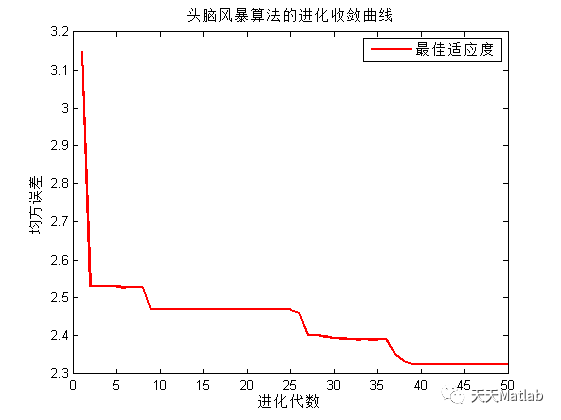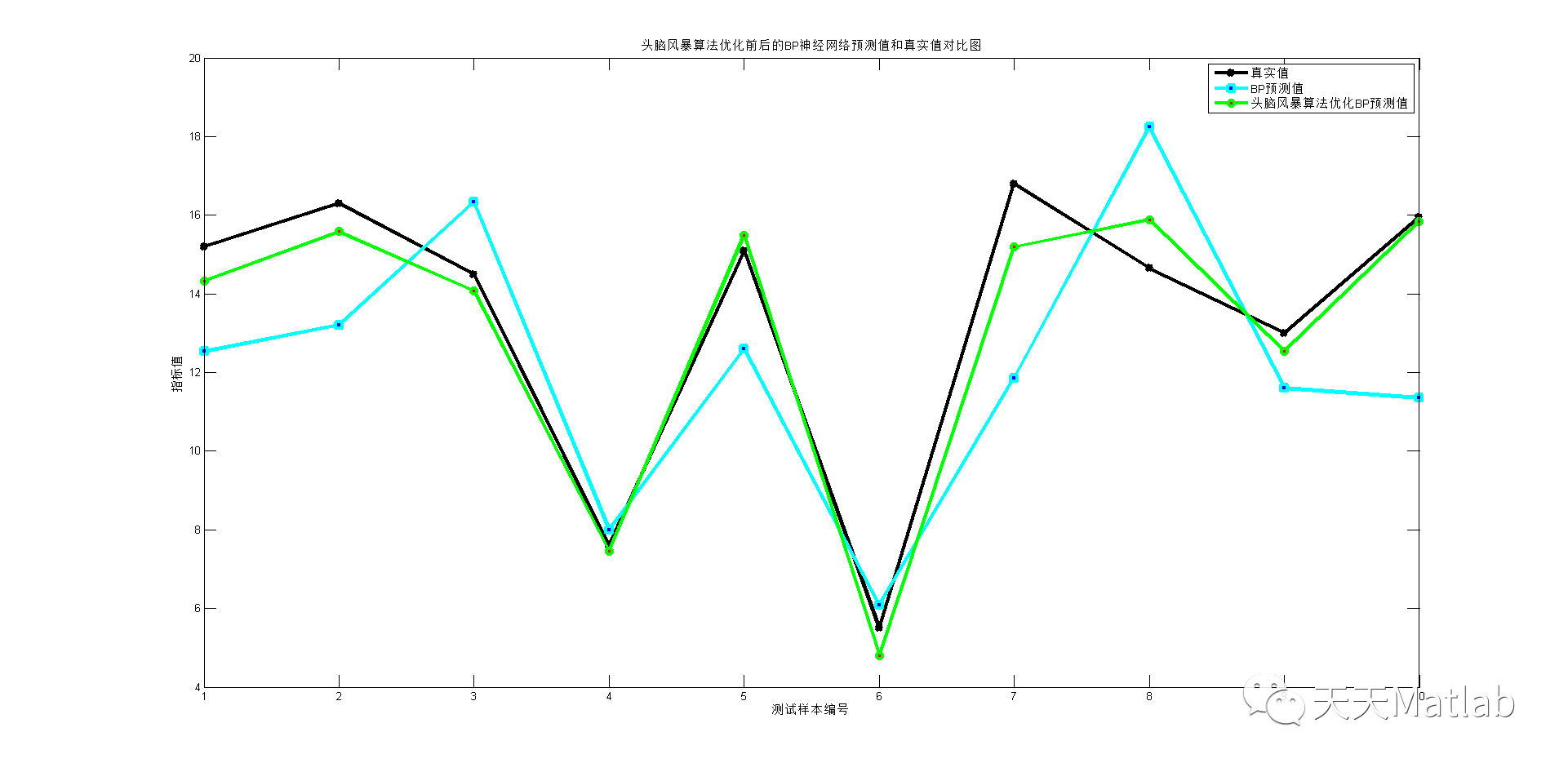?1 简介
针对基于传统BP神经网络的海水水质评价模型存在易陷入局部极小等问题,提出了一种新的利用头脑风暴优化算法(BSO)优化BP神经网络的海水水质评价模型(BSO-BP).该模型引入具有全局寻优特点的头脑风暴优化算法,用于模拟人类提出创造性思维解决问题的过程,具有强大的全局搜索和局部搜索的能力,同时利用BP神经网络所具有良好的非线性映射能力,学习适应能力和容错性,最大程度上考虑到海洋水质评价因素的非线性和非平稳的关系,得到BP神经网络的各层权值,阈值的最优解,使得海水水质评价结果准确合理.并以胶州湾海域的12个监测站位的监测数据作为评价样本进行水质评价,实验结果表明该评价模型能够克服局部极小问题,评价结果准确性较高,并具有一定的实用性.
受人类创造性解决问题过程--头脑风暴会议的启发, 2011年史玉回老师 在第二次群体智能国际会议(The Second International Conference on Swarm Intelligence(ICSI11))中提出一种新的群智能优化算法--头脑风暴优化算法,算法采用聚 类思想搜索局部最优,通过局部最优的比较得到全局最优;采用变异思想增加了算法的多 样性,避免算法陷入局部最优,在这聚与散相辅相承的过程中搜索最优解,思想新颖,适合于解决多峰高维函数问题。
2 部分代码
function best_fitness = bso2(fun,n_p,n_d,n_c,rang_l,rang_r,max_iteration)
% fun = fitness_function
% n_p; population size
% n_d; number of dimension
% n_c: number of clusters
% rang_l; left boundary of the dynamic range
% rang_r; right boundary of the dynamic range
prob_one_cluster = 0.8;? ? ? ? ? ? ? ? ? ? ? ? ? ? ? ? ? ? % probability for select one cluster to form new individual;?
stepSize = ones(1,n_d);? ? ? ? ? ? ? ? ? ? ? ? ? ? ? ? ? ? % effecting the step size of generating new individuals by adding random values
popu = rang_l + (rang_r - rang_l) * rand(n_p,n_d);? ? ? ? ?% initialize the population of individuals
popu_sorted? = rang_l + (rang_r - rang_l) * rand(n_p,n_d); % initialize the? population of individuals sorted according to clusters
n_iteration = 0;? ? ? ? ? ? ? ? ? ? ? ? ? ? ? ? ? ? ? ? ? ?% current iteration number
% initialize cluster probability to be zeros
prob = zeros(n_c,1);
best = zeros(n_c,1);? ? ? ? ? ? ? ? ? ? ? ? ? ? ? ? ? ? ? ?% index of best individual in each cluster
centers = rang_l + (rang_r - rang_l) * rand(n_c,n_d);? ? ? % initialize best individual in each cluster
centers_copy = rang_l + (rang_r - rang_l) * rand(n_c,n_d); % initialize best individual-COPY in each cluster FOR the purpose of introduce random best
best_fitness = 1000000*ones(max_iteration,1);
fitness_popu = 1000000*ones(n_p,1);? ? ? ? ? ? ? ? ? ? ? ? % store fitness value for each individual
fitness_popu_sorted = 1000000*ones(n_p,1);? ? ? ? ? ? ? ? ?% store? fitness value for each sorted individual
indi_temp = zeros(1,n_d);? ? ? ? ? ? ? ? ? ? ? ? ? ? ? ? ? % store temperary individual
% calculate fitness for each individual in the initialized population
for idx = 1:n_p
? ? fitness_popu(idx,1) = fun(popu(idx,:));
end
while n_iteration < max_iteration? ?
? ? ? cluster = kmeans(popu, n_c,'Distance','cityblock','Start',centers,'EmptyAction','singleton'); % k-mean cluster
? ? ? % clustering? ??
? ? ? fit_values = 100000000000000000000000000.0*ones(n_c,1);? % assign a initial big fitness value? as best fitness for each cluster in minimization problems
? ? ? number_in_cluster = zeros(n_c,1);? ? ? ? ? ? ? ? ? ? ? ? % initialize 0 individual in each cluster
? ? ? for idx = 1:n_p
? ? ? ? ? number_in_cluster(cluster(idx,1),1)= number_in_cluster(cluster(idx,1),1) + 1;? ? ??
? ? ? ? ? % find the best individual in each cluster
? ? ? ? ? if fit_values(cluster(idx,1),1) > fitness_popu(idx,1)? % minimization
? ? ? ? ? ? ?fit_values(cluster(idx,1),1) = fitness_popu(idx,1);
? ? ? ? ? ? ?best(cluster(idx,1),1) = idx;
? ? ? ? ? end
? ? ? end??
? ? ? % form population sorted according to clusters
? ? ? counter_cluster = zeros(n_c,1);? % initialize cluster counter to be 0?
? ? ? acculate_num_cluster = zeros(n_c,1);? % initialize accumulated number of individuals in previous clusters
? ? ? for idx =2:n_c
? ? ? ? ? acculate_num_cluster(idx,1) = acculate_num_cluster((idx-1),1) + number_in_cluster((idx-1),1);
? ? ? end
? ? ? %start form sorted population
? ? ? for idx = 1:n_p
? ? ? ? ? counter_cluster(cluster(idx,1),1) = counter_cluster(cluster(idx,1),1) + 1 ;
? ? ? ? ? temIdx = acculate_num_cluster(cluster(idx,1),1) +? counter_cluster(cluster(idx,1),1);
? ? ? ? ? popu_sorted(temIdx,:) = popu(idx,:);
? ? ? ? ? fitness_popu_sorted(temIdx,1) = fitness_popu(idx,1);
? ? ? end??
? ? ? % record the best individual in each cluster
? ? ? for idx = 1:n_c
? ? ? ? ? centers(idx,:) = popu(best(idx,1),:);? ? ? ??
? ? ? end??
? ? ? if (rand() < 0.2) %? select one cluster center to be replaced by a randomly generated center
? ? ? ? ?cenIdx = ceil(rand()*n_c);
? ? ? ? ?centers(cenIdx,:) = rang_l + (rang_r - rang_l) * rand(1,n_d);
? ? ? end? ? ? ? ?
? ? ? % calculate cluster probabilities based on number of individuals in each cluster
? ? ? for idx = 1:n_c
? ? ? ? ? prob(idx,1) = number_in_cluster(idx,1)/n_p;
? ? ? ? ? if idx > 1
? ? ? ? ? ? ?prob(idx,1) = prob(idx,1) + prob(idx-1,1);
? ? ? ? ? end
? ? ? end
? ? ? % generate n_p new individuals by adding Gaussian random values? ? ? ? ? ?
? ? ? for idx = 1:n_p
? ? ? ? ? r_1 = rand();? ? ? ? ? ? ?% probability for select one cluster to form new individual
? ? ? ? ? if r_1 < prob_one_cluster? % select one cluster
? ? ? ? ? ? ?r = rand();
? ? ? ? ? ? ?for idj = 1:n_c
? ? ? ? ? ? ? ? ?if r < prob(idj,1)? ? ? ? ? ? ? ? ? ? ??
? ? ? ? ? ? ? ? ? ? if rand() < 0.4? % use the center
? ? ? ? ? ? ? ? ? ? ? ?indi_temp(1,:) = centers(idj,:);?
? ? ? ? ? ? ? ? ? ? else? ? ? ? ? ? ?% use one randomly selected? cluster
? ? ? ? ? ? ? ? ? ? ? ? indi_1 = acculate_num_cluster(idj,1) + ceil(rand() * number_in_cluster(idj,1));
? ? ? ? ? ? ? ? ? ? ? ? indi_temp(1,:) = popu_sorted(indi_1,:);??
? ? ? ? ? ? ? ? ? ? end
? ? ? ? ? ? ? ? ? ? break
? ? ? ? ? ? ? ? end
? ? ? ? ? ? ?end
? ? ? ? ? else % select two clusters
? ? ? ? ? ? ? ?% pick two clusters?
? ? ? ? ? ? ? ?cluster_1 = ceil(rand() * n_c);
? ? ? ? ? ? ? ?indi_1 = acculate_num_cluster(cluster_1,1) + ceil(rand() * number_in_cluster(cluster_1,1));
? ? ? ? ? ? ? ?if indi_1==0
? ? ? ? ? ? ? ? ? ?indi_1=1;
? ? ? ? ? ? ? ?end
? ? ? ? ? ? ? ?cluster_2 = ceil(rand() * n_c);
? ? ? ? ? ? ? ?indi_2 = acculate_num_cluster(cluster_2,1) + ceil(rand() * number_in_cluster(cluster_2,1));?
? ? ? ? ? ? ? ?if indi_2==0
? ? ? ? ? ? ? ? ? ?indi_2=1;
? ? ? ? ? ? ? ?end
? ? ? ? ? ? ? ?tem = rand();
? ? ? ? ? ? ? ?if rand() < 0.5 %use center
? ? ? ? ? ? ? ? ? indi_temp(1,:) = tem * centers(cluster_1,:) + (1-tem) * centers(cluster_2,:);?
? ? ? ? ? ? ? ?else? ? ? ? ? ? % use randomly selected individuals from each cluster? ? ? ? ? ??
? ? ? ? ? ? ? ? ? indi_temp(1,:) = tem * popu_sorted(indi_1,:) + (1-tem) * popu_sorted(indi_2,:);?
? ? ? ? ? ? ? ?end
? ? ? ? ? end? ? ? ? ??
? ? ? ? ? stepSize = logsig(((0.5*max_iteration - n_iteration)/20)) * rand(1,n_d);
? ? ? ? ? indi_temp(1,:) = indi_temp(1,:) + stepSize .* normrnd(0,1,1,n_d);
? ? ? ? ? % if better than the previous one, replace it
? ? ? ? ? fv = fun(indi_temp);
? ? ? ? ? if fv < fitness_popu(idx,1)? % better than the previous one, replace
? ? ? ? ? ? ?fitness_popu(idx,1) = fv;
? ? ? ? ? ? ?popu(idx,:) = indi_temp(1,:);
? ? ? ? ? end
? ? ? end
? ? ? % keep the best for each cluster
? ? ? for idx = 1:n_c
? ? ? ? ? popu(best(idx,1),:) = centers_copy(idx,:);??
? ? ? ? ? fitness_popu(best(idx,1),1) = fit_values(idx,1);
? ? ? end
? ? ? n_iteration = n_iteration +1;
? ? ? % record the best fitness in each iteration
? ? ? best_fitness(n_iteration, 1) = min(fit_values);
end
3 仿真结果



4 参考文献
[1]李海涛, 邵泽东. 基于头脑风暴优化算法与BP神经网络的海水水质评价模型研究[J]. 应用海洋学学报, 2020, 39(1):6.
博主简介:擅长智能优化算法、神经网络预测、信号处理、元胞自动机、图像处理、路径规划、无人机等多种领域的Matlab仿真,相关matlab代码问题可私信交流。
部分理论引用网络文献,若有侵权联系博主删除。